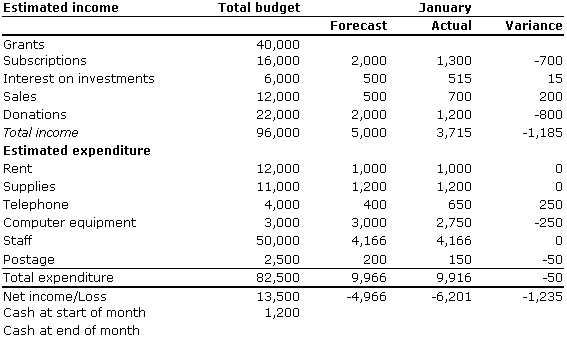Cash Flow Management
Cash flow management is critical to not only for-profit businesses, but also not-for-profit organisations to ensure they have enough money to pay the bills. These bills include day-to-day running expenses and large sums predicted and planned for in your annual budget.
In cash flow management, timing is critical. You must have money available to pay the bills when they come in. If you run out of cash you can't pay your bills on time - and unless arrangements are made to cover shortfalls, you may end up in financial difficulty. This difficulty could be as trivial as paying the phone bill late, but if you are not in control of your cash flow minor problems can escalate and you may have to lay off staff or, in the worst case scenario, wind up your organisation.
Even profitable organisations have gone under because of cash flow problems. It is the responsibility of every board member (and especially the treasurer) to ensure that systems are in place that will prevent the organisation from trading while insolvent. Any breach of this requirement can create financial risks for individual board members.
What exactly is a cash flow forecast (sometimes called a cash budget)?
A cash flow forecast has the following crucial characteristics:
- It is a numerical picture of your predicted flow of funds for a particular period, usually month-by-month for the year ahead. Some organisations find it helpful to look at shorter periods, such as weeks or fortnights, but although useful this is more time-consuming.
- It allows you to predict what cash you think will come in and how much will go out over that period.
- It is an extension of your budget, and you should do it at the same time as you prepare your budget for the year ahead.
- It is also an extension of your overall budgeting, but income and expenditure are allocated against a timeframe and the forecast does not follow accrual accounting. This means cash is recorded as it comes in and as it goes out, not when the financial commitment was made (e.g. invoices sent or supplies ordered).
If you have any sections or sub-committees that are responsible for their own budgets, ask them to contribute to your forecast or it will bear little resemblance to reality.
Draft the forecast so that the actual figures can be inserted next to the forecasted figures. This will allow you to analyse the data quickly to identify any significant variations.
If you don't do this, there's a risk you won't notice minor discrepancies and will lose the management value of the forecast. There's the added danger that the forecast may be used as the basis for the following year, so you'll perpetuate your errors. The point of the exercise is to make sure that you know at any time exactly where you stand.
Your cash flow forecast must also include estimated bank balances for easy comparison with your actual bank balances. The closing balance for each period is the opening balance for the next period.
Common elements of a cash flow Forecast are:
-
Cash in - Grants, sale of goods and services, subscriptions, return on investments, donations, fundraising activities, sale of assets, tax refunds.
Cash out - Operating activities, such as staff, telephone bills, power bills, rent, travel, stationery, printing and copying, postage, as well as servicing finance, tax, cash used to buy assets, equipment purchases and special project costs.
You can improve your cash flow management by:
- Developing an accurate cash flow forecast linked to your budget and strategic plan
- Separating the recording and handling of cash
- Banking cash promptly
- Paying most expenses by cheque so you have a record
- Having all cheques countersigned
- Keeping cash in a safe place
- Reconciling bank statements regularly
- Collecting money from debtors as quickly as possible
- Centralising payment procedures
- Developing close relationships with suppliers to negotiate mutually beneficial payment policies
- Reviewing your cash situation regularly and analysing significant discrepancies from your budget.
- Having appropriate authorisation and risk management policies.
- Managing cash holdings profitably

